#Ancient Greek Mysteries
Text
A Review of "The Eleusinian and Bacchic Mysteries" by Thomas Taylor
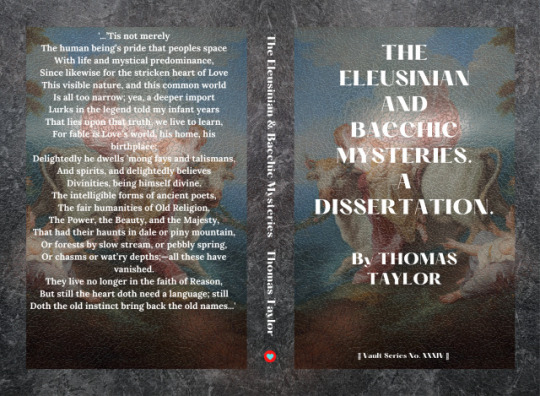
"The Eleusinian and Bacchic Mysteries" is an illuminating journey into the heart of ancient Greek religious practices, meticulously explored and vividly presented by the renowned philosopher and translator, Thomas Taylor. This dissertation, complemented by the evocative illustrations of A. L. Rawson, takes readers on a profound exploration of the mystical rituals that shaped the spiritual landscape of ancient Greece.
Thomas Taylor's scholarly expertise in Neoplatonism and his unwavering dedication to preserving the wisdom of the past shine brilliantly in this work. Through his meticulous translation and commentary, Taylor unveils the enigmatic rites and ceremonies of the Eleusinian and Bacchic Mysteries, providing readers with a window into the spiritual world of ancient Greece.
One of the most remarkable aspects of Taylor's work is his ability to convey the deep spiritual significance of these ancient rituals. He delves into the symbolism, mythology, and metaphysical underpinnings of the Mysteries, revealing how they were designed to facilitate personal transformation and spiritual enlightenment. Taylor's profound insights into the mysteries' inner workings give readers a profound understanding of their purpose and significance.
The accompanying illustrations by A. L. Rawson add another layer of richness to this dissertation. Rawson's artistry brings to life the mystical and mythological elements of the rituals, making the ancient world tangible and captivating. These illustrations serve as a visual guide, enhancing the reader's comprehension and engagement with the material.
"The Eleusinian and Bacchic Mysteries" is not merely a historical account but a spiritual odyssey. It invites readers to contemplate the enduring relevance of these ancient practices in the modern world. Taylor's work inspires us to reflect on the importance of initiation, transformation, and the quest for spiritual truth.
In conclusion, "The Eleusinian and Bacchic Mysteries" is a masterpiece of scholarship and spiritual insight. Thomas Taylor's dedication to preserving the wisdom of antiquity and his ability to convey its profound significance make this dissertation an invaluable resource for anyone interested in the spiritual and mystical traditions of ancient Greece. A. L. Rawson's illustrations add a visually captivating dimension to this already enlightening work. It is a must-read for seekers of wisdom, scholars, and those fascinated by the mysteries of the past.
"The Eleusinian and Bacchic Mysteries" by Thomas Taylor is available in Amazon in paperback 13.99$ and hardcover 19.99$ editions.
Length of the Book: 184 pages
Language: English
Rating 8/10
Link of the book!
Review by King's Cat
#Ancient Greek Mysteries#Eleusinian Mysteries#Bacchic Mysteries#Neoplatonism#Spiritual Enlightenment#Rituals and Ceremonies#Symbolism and Mythology#Spiritual Transformation#Thomas Taylor#A. L. Rawson#Ancient Greek Religion#Mystical Traditions#Spiritual Wisdom#Initiation#Metaphysical Insights#Illustrations of Ancient Rituals#Philosophical Discourse#Esoteric Knowledge#Spiritual Quest#Historical Dissertation
3 notes
·
View notes
Text
A Review of "The Eleusinian and Bacchic Mysteries" by Thomas Taylor

"The Eleusinian and Bacchic Mysteries" is an illuminating journey into the heart of ancient Greek religious practices, meticulously explored and vividly presented by the renowned philosopher and translator, Thomas Taylor. This dissertation, complemented by the evocative illustrations of A. L. Rawson, takes readers on a profound exploration of the mystical rituals that shaped the spiritual landscape of ancient Greece.
Thomas Taylor's scholarly expertise in Neoplatonism and his unwavering dedication to preserving the wisdom of the past shine brilliantly in this work. Through his meticulous translation and commentary, Taylor unveils the enigmatic rites and ceremonies of the Eleusinian and Bacchic Mysteries, providing readers with a window into the spiritual world of ancient Greece.
One of the most remarkable aspects of Taylor's work is his ability to convey the deep spiritual significance of these ancient rituals. He delves into the symbolism, mythology, and metaphysical underpinnings of the Mysteries, revealing how they were designed to facilitate personal transformation and spiritual enlightenment. Taylor's profound insights into the mysteries' inner workings give readers a profound understanding of their purpose and significance.
The accompanying illustrations by A. L. Rawson add another layer of richness to this dissertation. Rawson's artistry brings to life the mystical and mythological elements of the rituals, making the ancient world tangible and captivating. These illustrations serve as a visual guide, enhancing the reader's comprehension and engagement with the material.
"The Eleusinian and Bacchic Mysteries" is not merely a historical account but a spiritual odyssey. It invites readers to contemplate the enduring relevance of these ancient practices in the modern world. Taylor's work inspires us to reflect on the importance of initiation, transformation, and the quest for spiritual truth.
In conclusion, "The Eleusinian and Bacchic Mysteries" is a masterpiece of scholarship and spiritual insight. Thomas Taylor's dedication to preserving the wisdom of antiquity and his ability to convey its profound significance make this dissertation an invaluable resource for anyone interested in the spiritual and mystical traditions of ancient Greece. A. L. Rawson's illustrations add a visually captivating dimension to this already enlightening work. It is a must-read for seekers of wisdom, scholars, and those fascinated by the mysteries of the past.
"The Eleusinian and Bacchic Mysteries" by Thomas Taylor is available in Amazon in paperback 13.99$ and hardcover 19.99$ editions.
Length of the Book: 184 pages
Language: English
Rating 8/10
Link of the book!
Review by King's Cat
#Ancient Greek Mysteries#Eleusinian Mysteries#Bacchic Mysteries#Neoplatonism#Spiritual Enlightenment#Rituals and Ceremonies#Symbolism and Mythology#Spiritual Transformation#Thomas Taylor#A. L. Rawson#Ancient Greek Religion#Mystical Traditions#Spiritual Wisdom#Initiation#Metaphysical Insights#Illustrations of Ancient Rituals#Philosophical Discourse#Esoteric Knowledge#Spiritual Quest#Historical Dissertation
0 notes
Text
The Petelia Tablet, Greek, c.300-200 BCE: this totenpass (a "passport for the dead") was meant to be buried in a human grave; it bears an inscription that tells the dead person exactly where to go and what to say after crossing into the Greek Underworld
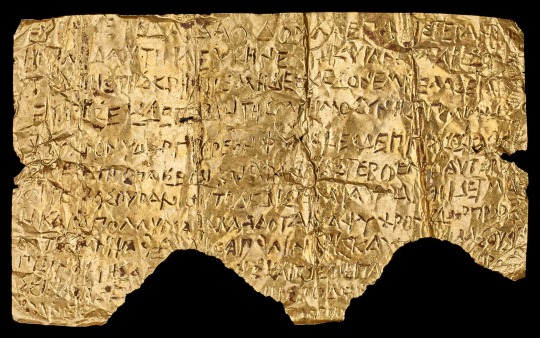
Made from a sheet of gold foil, this tablet measures just 4.5cm (a little over 1.5 inches) in length, and although it was found inside a pendant case in Petelia, Italy, it's believed to have originated in ancient Greece. It was meant to aid the dead in their journey through the Underworld -- providing them with specific instructions, conferring special privileges, and granting them access to the most coveted realms within the afterlife.
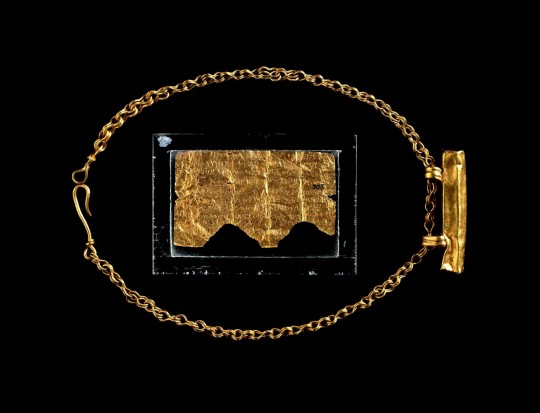
The Petelia tablet, displayed with the pendant case in which it was discovered
The tablet itself dates back to about 300-200 BCE, while the pendant case/chain that accompanies it was likely made about 400 years later, during the Roman era. It's believed that the tablet was originally buried with the dead, and that an unknown individual later removed it from the burial site and stuffed it into the pendant case. Unfortunately, in order to make it fit, they simply rolled it up and then snipped off the tip of the tablet. The final lines of the inscription were destroyed in the process.

The inverse side of the Petelia tablet
These textual amulets/lamellae are often referred to as totenpässe ("passports for the dead"). They were used as roadmaps to help guide the dead through the Underworld, but they also served as indicators of the elite/divine status of certain individuals, ultimately providing them with the means to obtain an elevated position in the afterlife.
The Petelia tablet is incised with an inscription in ancient Greek, and the translated inscription reads:
You will find a spring on your left in Hades’ halls, and by it the cypress with its luminous sheen.
Do not go near this spring or drink its water. You will find another, cold water flowing from Memory’s lake; its guardians stand before it.
Say: "I am a child of Earth and starry Heaven, but descended from Heaven; you yourselves know this. I am parched with thirst and dying: quickly, give me the cool water flowing from Memory’s lake."
And they will give you water from the sacred spring, and then you will join the heroes at their rites.
This is [the ... of memory]: [on the point of death] ... write this ... the darkness folding [you] within it.
The final section was damaged when the tablet was shoved into the pendant case; sadly, that part of the inscription does not appear on any of the other totenpässe that are known to exist, so the meaning of those lines remains a mystery (no pun intended).
Lamellae that are inscribed with this motif are very rare. They're known as "Orphic lamellae" or simply "Orphic tablets." As the name suggests, these inscriptions are traditionally attributed to an Orphic-Bacchic mystery cult.
The inscriptions vary, but they generally contain similar references to a cypress tree, one spring that must be avoided, another spring known as the "Lake of Memory," the sensation of thirst, and a conversation with a guardian (or another entity within the Underworld, such as the goddess Persephone) in which the dead must present themselves as initiates or divine individuals in order to be granted permission to drink from the Lake of Memory. They are thereby able to obtain privileges that are reserved only for the elite.
Though the specifics of this reward are often vague, it may have been viewed as a way to gain access to the Elysian Fields (the ancient Greek version of paradise) or as a way to participate in sacred rites; some totenpässe suggest that it may have allowed the soul to break free from the eternal cycle of reincarnation. Regardless, the overall objective was likely the same: to obtain a special status and acquire privileges that were inaccessible to most of the souls in the Underworld.
Sources & More Info:
Altlas Obscura: The Ancient Greeks Created Golden Passports to Paradise
The Museum of Cycladic Art: The Bacchic-Orphic Underworld
Bryn Mawr College: Festivals in the Afterlife: a new reading of the Petelia tablet
The Getty Museum: Underworld (imagining the afterlife)
The British Museum: Petelia tablet (with pendant case; chain)
#archaeology#history#anthropology#ancient greece#ancient history#greek mythology#Petelia tablet#Greek mysteries#orphic mysteries#orphism#greek underworld#hades#persephone#anthropology of death#religon#afterlife#tw death#classical antiquity#classical archaeology#ticket to paradise#whoever damaged this#probably#got#a#ticket#to tartarus#instead
2K notes
·
View notes
Text

Classicstober day 7: Persephone 🌸
#flaroh illustration#tagamemnon#ancient history#ancient greece#greek mythology#persephone#eleusinian mysteries#proserpina#hellenic mythology#hellenic pagan#classicstober23#classicstober#classical reception
725 notes
·
View notes
Text
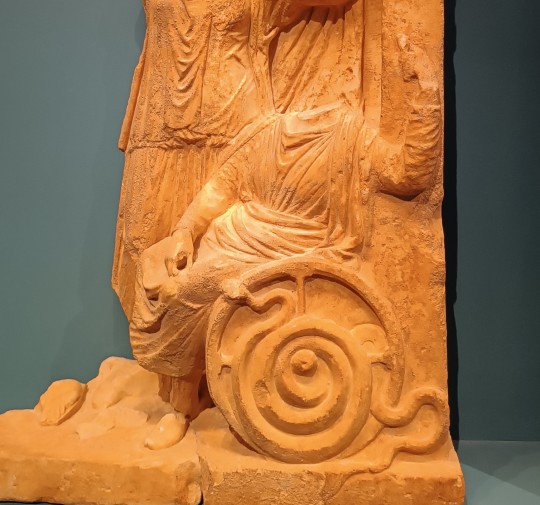
FREAKING TRIPTOLEMUS and his chariot which my entire family agrees looks like a wheelchair, which. The design potential!!!!

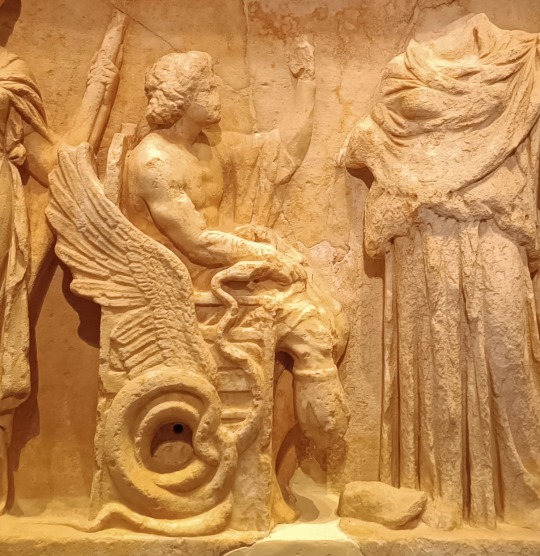
Pics from my eleusis visit from yesterday.
102 notes
·
View notes
Text

Greek Archaeologists Discover Mysterious 4,000-Year-Old Building on Hill Earmarked for New Airport
Archaeologists on the Greek island of Crete have uncovered a monumental ancient structure that threatens to halt progress on the construction of a new airport.
The structure belonged to the Minoan civilization and was mainly used between 2000 and 1700 B.C.E., around the same time that Crete’s monumental palaces at Knossos and Phaistos were built, per the Greek City Times.
But unlike these palaces and other feats of Minoan architecture, the purpose of the building remains unknown, and it’s now the subject of much archaeological attention and speculation.
The structure resembles “a huge car wheel from above,” writes Nicholas Paphitis for the Associated Press, with a diameter of 157 feet and a total area of 19,000 square feet.
According to a statement from the Greek Ministry of Culture, some of the structure’s features are comparable to Minoan tombs, including its circular arrangement of stone rings and its intricate layout. But a large quantity of ancient animal bones found nearby is complicating researchers’ understanding of the site.
“It may have been periodically used for possibly ritual ceremonies involving consumption of food, wine and perhaps offerings,” says the statement, per a translation by the AP.

While archaeologists further excavate and study the building, which sits on top of Papoura Hill, near the town of Kastelli, they must contend with the hilltop’s future function: a planned radar station for Crete’s new international airport.
Beginning in 2027, the airport will serve Heraklion, Crete’s capital and largest city, as well as a wealth of cultural and archaeological sites across the island.
Eighteen million passengers are projected to use the airport annually once construction is complete, the AP reports. Tourists want to visit Crete’s well-preserved historical sites, but they need convenient, modern infrastructure to take them there.
At times, rampant tourism threatens the integrity of ancient sites in Greece, prompting the government to take protective measures, like limiting the number of visitors to the Acropolis in Athens.

Per the statement, excavations in the area uncovered at least 35 other archaeological sites. As Greek authorities build Crete’s new airport and the network of roads needed to connect it with the rest of the island, they must continually strike a balance between innovation and maintaining cultural heritage.
In the statement, Culture Minister Lina Mendoni describes the structure as a unique find of great interest. She says the Greek government and airport officials will explore alternative locations for the radar station to ensure the preservation of this historically significant archaeological site.
“It’s possible to go ahead with the airport while granting the antiquities the protection they merit,” Mendoni adds, per the AP. Her comments offer hope that Crete’s past, present and future will once again be reconciled.
By Eli Wizevich.

#Greek Archaeologists Discover Mysterious 4000-Year-Old Building on Hill Earmarked for New Airport#Crete#Minoan civilization#temple#ancient artifacts#archeology#archeolgst#history#history news#ancient history#ancient culture#ancient civilizations#greek history
52 notes
·
View notes
Text
Most people are familiar with the story of Atlantis, the legendary sunken city as described by the ancient Greek philosopher Plato.
32 notes
·
View notes
Text
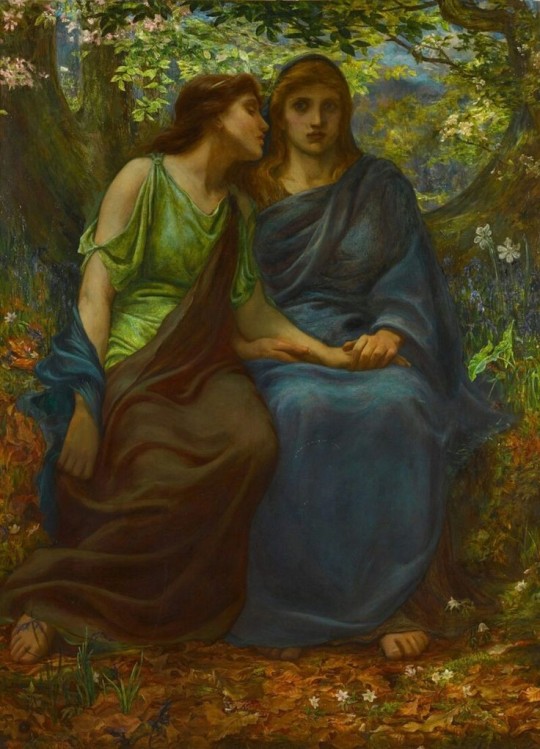
Faces/Gods/Heroes participating in the Eleusinian drama: Although we may not know exactly how the plot unfolded or what roles each hero or god played we find these present (our source is ancient art depicting facets of the Mysteries): Triptolemus, first priest of the Mysteries and son of the Eleusinian King Celeus, goddess Demeter, mother of Persephone (usually mentioned as Kore), Persephone, queen of the Underworld, Dionysus in his role as Pluto, Semele, mother of Dionysus. Elsewhere we find: Demeter accompanied by the child Pluto and her daughter Persephone, the hero Eubouleus, Triptolemus, Herakles, Dionysus, again Dionysus' mother Semele. Other persons: Aphrodite, goddess of the divine marriage to happen, Hermes and Athena, liitle child Iacchus, Zeus in his throne, close to him Hera.
Art: Demeter and Persephone by John D Batten
#mythology#art#symbolism#ancient greece#greek gods#mysticism#eleusis#greek myths#eleusinian mysteries#heroes#gods#demeter#pluto#persephone#semele#dionysus#john d batten#initiation
23 notes
·
View notes
Text
Chapter length: 8k
Summary: Callum and Rayla finally talk. Ezran interrogates Viren, part one.
a/n: tw for mental health related stuff in regards to rayla (implied depression, self loathing, and stuff that may veer into emotional self harm / passive suicidal ideation territory). i don't think any of it is super intense but i also don't know your circumstances, so please keep that in mind as you go forward. that said, it is discussed in a very hurt/comfort kind of way.
CHAPTER 7: At The End of the Tunnel
Callum led the way up and out of the tunnel, holding her wrist with one hand and his staff in front as a light source with the other. His hand was warm against Rayla’s skin, his gait steady over the rocky, uneven ground.
There was so much she wanted to stay —about Claudia, and her potential plans—and even more she was curious about—had Callum eaten? Had he slept? And why had the Earthblood elf boy saved them, truly?—but she was so tired.
Rayla hadn’t realized just how much adrenaline she’d been carrying in her body between worrying about Callum and constantly keeping her guard up around Claudia, with no sleep or food or hardly any water the past two days. But it hadn’t been for nothing, her free hand drifting to the hard lump in her pouch, five sun rubies in total crammed in next to the coins. All safe.
She squinted as a shaft of light appeared maybe ten feet ahead, the ground sloping upwards as they followed the phases of the moon back toward the surface. Relief washed over her in waves as the light grew brighter, bigger, haloing Callum’s silhouette of a windswept-haired head and broadened shoulders.
He picked up the pace, not looking back, as her muscles became mush. But they were almost there. She could keep going. Just a few more steps to the surface, and then—
Rayla’s foot caught on a rock. She stumbled. She slipped, both hands scraping against the ground.
Callum glanced back immediately, turning round and dropping to the ground in front of her, grasping at her arms, eyebrows knit with worry. “Hey, you okay?”
“I’m fine,” she croaked, holding still while he inspected the number of tiny scratches on her hands. The light of his staff illuminated the faint traces of blood.
#gee i wonder what ancient greek myth im referencing. a MYSTERY#rayllum#tdp#the dragon prince#ezran#morally ambiguous fam#fic: teach me how to name the bigger light#brotp: best crownguard#my fic#fic
30 notes
·
View notes
Text
Do you remember the scene where Richard and Francis discover a mysterious large cat-like animal? Why would Donna include a mention of the scary "cat" in The Secret History? Is there a possibility that our Greek group didn't kill the farmer? Or is there another, maybe symbolic explanation to this?
#the secret history donna tartt#the secret history aesthetic#the secret history#richard papen#charles macaulay#camilla macaulay#bunny corcoran#henry winter#francis abernathy#donna tartt#ancient greek literature#the little friend#the goldfinch#classic literature#literature#mystery#secret history#secret#book recommendations
235 notes
·
View notes
Text
can't believe people just live their day to day lives without thinking about the eleusinian mysteries??? like??? not even once????
#not even kore?#KORE?#persephone#mystery cult#eleusinian mysteries#cult#tagamemnon#queueusque tandem abutere catilina patientia nostra#demeter#ancient greece#greek mythology#greek gods#history#queue are made by history#archaeology
21 notes
·
View notes
Text
When you come back to Identity V after a 2 year hiatus and see the fanbase siblingize the two characters who share parallels to ancient Greek lovers:

#identity v#like... idk how to rlly articulate this but... so far Im seeing Greek gods and mythology being referenced in AOM.#Orpheus' and Alice's pasts are ambiguous to keep people interested in the story's mystery... but the Orpheus and Eurydice stuff#is uh. rlly telling.#like i rlly don't think IDV wants you to see them as siblings... especially siblings with parallels to past lovers#i mean IDV could get weird with Alice and Orpheus by making them siblings since this is a horror game#but. i dont see that happening.#tbh i think the ppl calling them siblings should be like. concerned that these two parallel ancient lovers [Orpheus and Eurydice]#cuz the writers could go there u know...#i think ppl who are calling them siblings have never read the lore or watched the lore videos.#like they just get their information from other sources besides the actual canon material.#anyways...
7 notes
·
View notes
Text
Working on researching more obscure non-Attic Ancient Greek religion be like:
Me: Which deity was worshipped most in this region
Google: a Goddess who was not named but used this title, Despoine, in the mystery tradition, later conflated with these other goddesses from these other mysteries
Me: Yeh but who was the original goddess, before the conflations
Google: Bitch I just said it was a mystery didn't I?
#despoine#arkadia#arcadia#ancient greek religion#greek mysteries#arkadian mysteries#she was a sister of persephone at first not equated#also its a epithet of artemis hekate and persephone#demeter was her mom#void post
19 notes
·
View notes
Text
In the Plain of Nysa Research Notes
Hi everyone! As announced last week I am going to post my research notes on the Eleusinian Mysteries here on tumblr. However my research notes are pretty damn long (24 pages to be exact) and still not 100% complete to say the very least.
So I shall post my research notes on this topic in separate parts. I hope y’all will find joy in my research notes regardless
#in the plain of nysa#trigun#trigun stampede#vashwood#vash the stampede#persephone au#nicholas d. wolfwood#the eleusinian mysteries#archeology#classical archaeology#ancient greece#demeter#eleusis#ancient greek mythology#greek gods#greek myth#greek mythology#greek archaeology#greek temple#ancient history#history
4 notes
·
View notes
Text
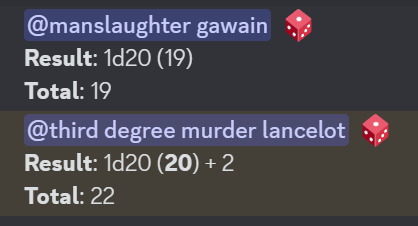
i could've killed god after this roll
#loz speaks.#loz plays dnd.#kim tag.#thank you kim for having faith in the dice even when i didn't#and thank you also for including the noble epic of schelemeus in the oneshot i will be cackling about it for the next business week#gay ancient greek ghost story murder mystery cast my fucking beloveds
3 notes
·
View notes
Note
ah oui tu as appris la totale! (latin et grec😳) et tu préfères quoi entre les deux?👀
(ahaha don’t know if you’re fluent in french so speak in the language you’re comfortable with!)
pas du tout, i still understand it (which is extremely useful if you're in europe and use vinted regularly) but i don't remember how to say anything 😂
i usually had the two classes back to back (for an inhuman amount of hours too), it was the same professor, and i had a similar level in both languages so in my mind they're kinda the same thing asjdkasd but ancient greek was a lot more fun bc i got to write in a different alphabet!
#also people usually made wilder mistranslations for ancient greek maybe bc it was less intuitive with our own languages#idk how things work anywhere else but we were just given short stories (that were actually chapters) and told to translate them#both to and from latin/ancient greek#i've never had any clue about morphosyntactic analysis so i always failed that half of the work <3#my translations were perfect though which is a mystery to everyone#asks#pamouche
4 notes
·
View notes